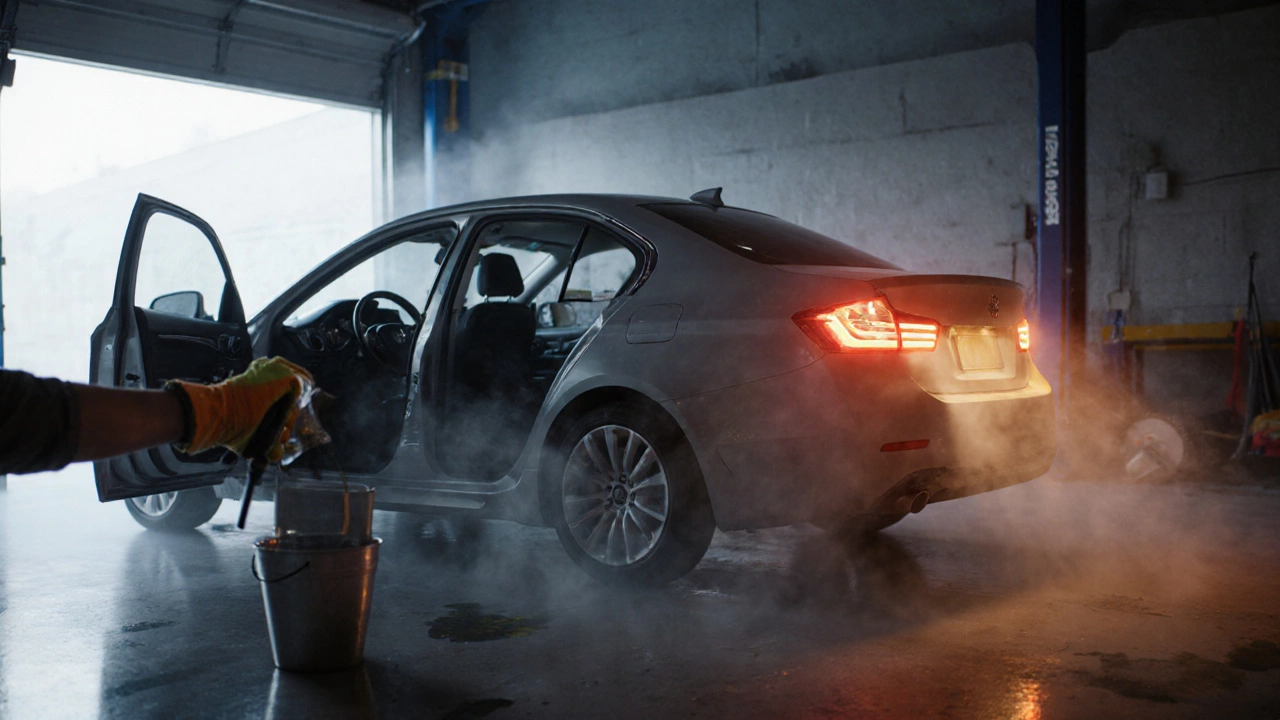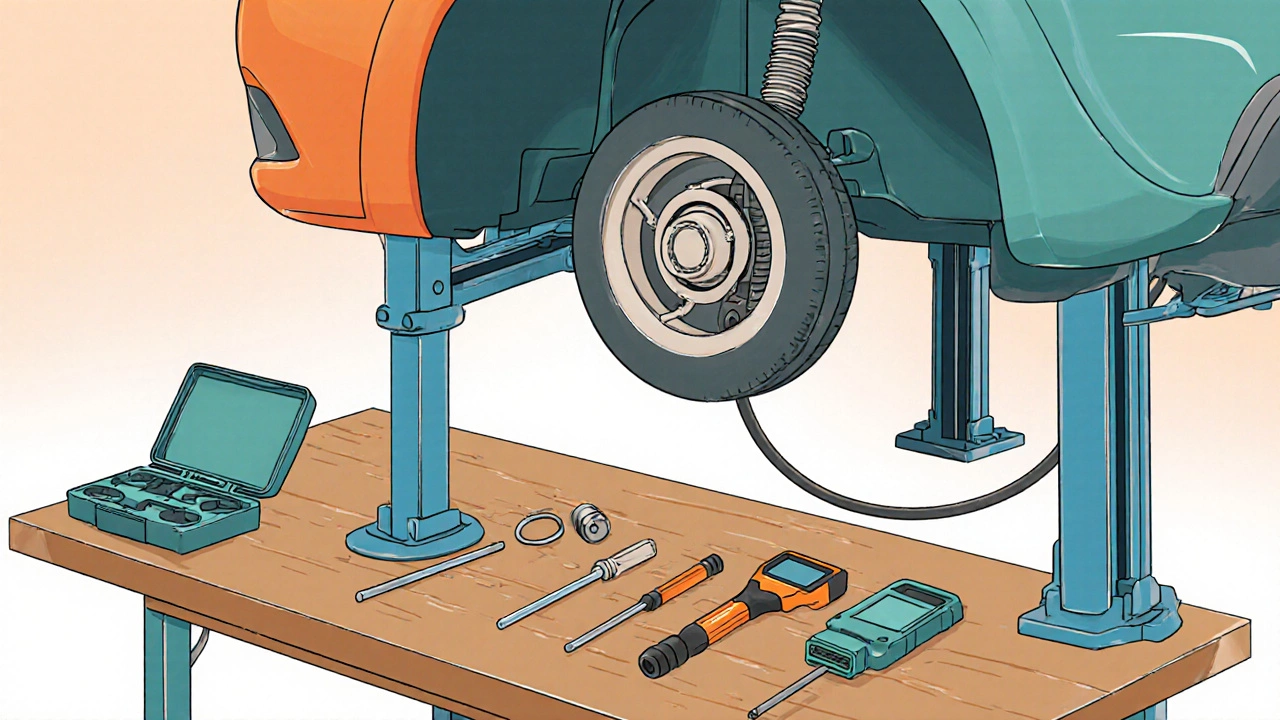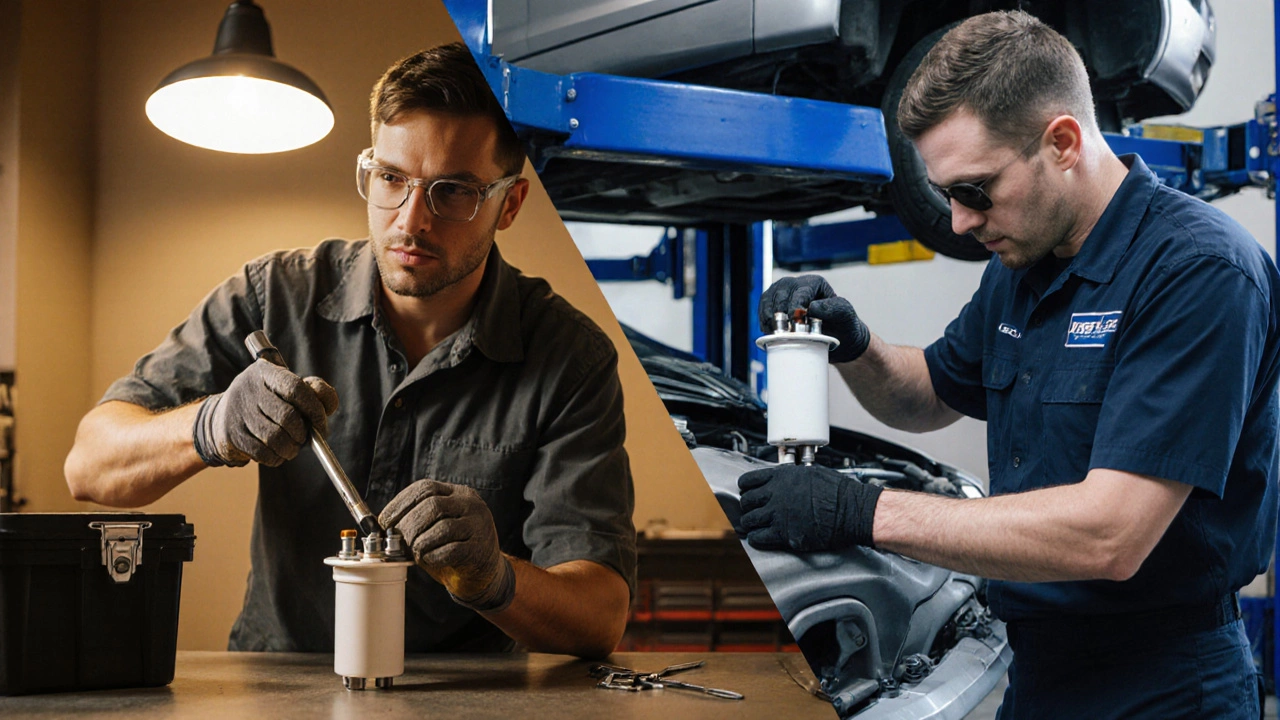 Oct, 20 2025
Oct, 20 2025
Fuel Pump Replacement Cost Calculator
Estimate Your Fuel Pump Replacement Costs
Compare DIY and professional replacement options to make an informed decision.
Safety & Warranty Considerations
Key Takeaways
- Replacing a fuel pump is doable for confident DIYers with basic tools and safety gear.
- Expect 2‑4 hours of work and $150‑$250 in parts if you buy a quality pump.
- Common pitfalls: forgetting to relieve fuel pressure, damaging the fuel line, and skipping the post‑install test.
- When in doubt, a professional can finish the job in half the time and guarantee warranty compliance.
- Safety first: work in a well‑ventilated area, use a jack stand, and wear safety glasses.
When your car starts to sputter, a Fuel Pump is the component that pushes gasoline from the tank to the engine at the right pressure is often the culprit. The question on most owners' minds is whether swapping that part out is something they can tackle on a weekend or if they need a shop lift and a mechanic’s bill.
What Exactly Does a Fuel Pump Do?
The Fuel Pump belongs to the Fuel System a network of tank, lines, filter, and injectors that delivers fuel to the combustion chamber. It creates the pressure needed for the injectors to spray a fine mist into each cylinder. When pressure drops, the engine can misfire, stall, or refuse to start.
When Should You Consider a Replacement?
Typical warning signs include:
- Engine stalls under load (e.g., going uphill)
- Hard starts after the car sits for a few hours
- Whining noise from the rear of the vehicle
- Fuel smell around the rear area
If a diagnostic scan shows a Fuel Pressure Sensor a sensor that tells the ECU how much pressure the pump is generating fault, it’s a good hint the pump is weak.

Tools and Safety Gear You’ll Need
Gather these before you lift the car. Each item is marked only once with microdata to keep the markup clean.
- Car Jack hydraulic or scissor jack rated for your vehicle’s weight and a set of jack stands.
- Safety Glasses protect eyes from fuel spray and metal shards.
- Socket set (10 mm and 13 mm are common)
- Flat‑head screwdriver
- Fuel line disconnect tool (optional but makes the job easier)
- OBD‑II Scanner device to clear error codes after the install
- New Fuel Pump (make sure it matches your vehicle’s make, model, and year)
- Container for old fuel (plastic bucket with a lid)
- Basic Mechanical Tools wrenches, pliers, and a torque wrench for re‑tightening bolts
Step‑By‑Step Guide to a DIY Fuel Pump Replacement
- Relieve fuel pressure. Remove the fuel pump fuse or relay, then start the engine and let it run until it stalls. This dumps most of the pressure from the lines.
- Disconnect the battery. Pull the negative terminal to avoid sparks.
- Lift the rear of the car. Position the Car Jack under the designated lift points, raise the vehicle, and support it with jack stands.
- Drain any residual fuel. Place a bucket underneath the fuel tank vent line and carefully siphon out the last few ounces.
- Remove the fuel tank. Unbolt the straps, disconnect the fuel filler hose, vapor return line, and the electrical connector that powers the pump.
- Access the pump. Most modern cars have the pump mounted inside the tank and secured with a retaining ring. Use a screwdriver to pop the ring off.
- Swap the pump. Pull the old pump out, compare it with the new unit, transfer the fuel filter (if reusable), and install the new pump. Re‑attach the retaining ring.
- Re‑install the tank. Reverse the removal steps, ensuring all fuel lines snap back into place and the electrical connector clicks.
- Reconnect the battery and run a test. Turn the key to “ON” - you should hear the pump prime for a few seconds. Start the engine; it should run smoothly.
- Clear codes. Hook up the OBD‑II Scanner and erase any lingering faults.
If everything sounds normal, lower the car, take it for a short drive, and listen for any leaks.
DIY vs. Professional Replacement - Quick Comparison
| Aspect | Do‑It‑Yourself | Professional Shop |
|---|---|---|
| Cost (parts + labor) | ~$150‑$250 (parts only) | ~$400‑$700 (parts + labor) |
| Time required | 2‑4 hours | 1‑2 hours |
| Skill level | Intermediate (basic mechanical confidence) | Expert (certified technicians) |
| Warranty impact | May void OEM warranty if not performed correctly | Warranty remains intact |
| Risk of fuel leak | Higher if steps missed | Low - shop has proper equipment |

Common Pitfalls and How to Avoid Them
- Skipping pressure release. Even a small amount of pressurized fuel can spray when you disconnect lines.
- Forgetting to disconnect the fuel pump relay. The pump will keep running, draining the tank.
- Re‑using an old fuel filter. A clogged filter defeats a brand‑new pump.
- Over‑tightening bolts. Use a torque wrench; overtightening can crack the tank.
- Neglecting the post‑install test. Run the engine for at least 5 minutes and listen for hissing.
When to Call a Professional
If any of these apply, hand the job to a shop:
- You lack a proper Car Jack and jack stands.
- The fuel tank is rusted or the straps are corroded.
- You’re uncomfortable working with gasoline or the vehicle’s electrical system.
- Your car is still under factory warranty and you don’t want to risk voiding it.
Final Thoughts on the fuel pump replacement Question
So, is changing a fuel pump easy? For someone who’s comfortable with basic hand tools, a clean workspace, and a little patience, yes - it’s a straightforward job that can be completed in a few hours. The biggest hurdles are safety (fuel is flammable) and making sure you follow each step carefully. If you’re unsure about any part of the process, the cost of a professional install is usually less than the headache of a botched DIY.
How do I know if my fuel pump is the problem?
Listen for a whining noise from the rear, note hard starts, and check for a low‑fuel‑pressure code with an OBD‑II scanner. A pressure test at a shop can confirm it.
Do I need to replace the fuel filter when I change the pump?
Most experts recommend swapping the filter at the same time. A fresh filter prevents debris from reaching the new pump.
Can I use regular gasoline after a pump swap?
Yes. Follow the manufacturer’s octane recommendation for your engine. Using higher‑octane fuel won’t harm the new pump.
What safety gear is mandatory?
At minimum wear safety glasses, gloves, and work in a well‑ventilated area. A fire‑proof blanket is a good extra precaution.
Will a DIY pump replacement void my warranty?
If the vehicle is still under a dealer warranty, any DIY work that isn’t documented can be considered a modification and may void coverage. Check the warranty terms before you start.